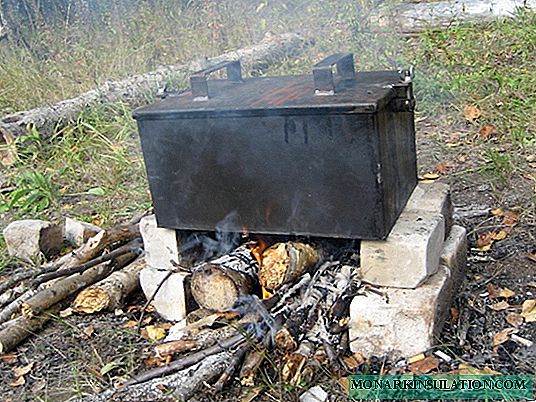
Any estate, whether it is a country cottage or a private house, must be provided with water. Without life-giving moisture, they cannot grow, delighting the eye with lush flowering, and no cultivated plants can fully bear fruit. A do-it-yourself water well, despite the seeming grandeur of the process, is a very real possibility of producing water, which can be carried out independently without using heavy drilling equipment. There are several drilling methods that are quite simple to implement and do not involve the use of expensive equipment and significant effort.
Varieties of downhole structures
Water production can be carried out using various technologies. The main types of water wells used to extract life-giving moisture:
- Arrangement of a well, which, in the presence of a good spring, quickly fills up and, being an excellent reservoir of water, can hold up to 2 cubic meters of water;
- A filter well on sand, which is a pipe d = 100 mm, immersed with a screw to a depth of 20-30 meters. A stainless steel mesh is fixed at the deepened end of the pipe, which acts as a filter while being immersed in coarse sand. The depth of the well is 10-50 meters, the service life is 5-15 years.
- A filterless artesian well used to extract water from formations of porous limestone rocks. The depth of the borehole is 20-100 meters, the service life is about 50 years.
The exact depth of the well for water cannot be determined previously. Tentatively, this will be the depth, like a similar well drilled in neighboring areas, or a well located nearby. Since deviations are possible due to the uneven occurrence of soil layers, casing pipes should be purchased based on the parameters of water supply sources already equipped on the site, but taking into account a slight adjustment.

The design of the water well is a kind of narrow well

The life of the wells directly depends on the intensity of use: the more often the structure is used, the longer it will last
Manual well drilling
To perform the work, a drill itself, a drill tower, a winch, rods and casing pipes are required. A drill tower is necessary when digging a deep well, with the help of this design, the drill is immersed and raised with rods.

The easiest way to drill a water well is a rotary well, which is carried out by rotating the drill
When drilling shallow wells, the drill string can be reached manually, completely dispensing with the use of a tower. Drill rods can be made of pipes, products are connected using dowels or threads. The lowest bar is additionally equipped with a drill.
Cutting nozzles are made of 3 mm sheet steel. When sharpening the edges of the nozzles, it should be noted that when the drill mechanism rotates, they must cut into the soil clockwise.

The drilling technology, familiar to most homeowners, is also applicable to the installation of a well under water
The tower is installed above the drilling site, its height must exceed the height of the drill rod in order to facilitate removal of the rod when lifting. Then, a guide recess for the drill is excavated on two bayonet shovels. The first turns of rotation of the drill can be performed by one person, but as the pipe sinks, additional help will be required. If the drill does not pull out the first time, turn it counterclockwise and try again.
As the drill deepens, the rotation of the pipe becomes more difficult. To facilitate the work, softening the soil with water will help. As the drill moves downward, every half meter, the drill structure should be brought to the surface and freed from the ground. The drilling cycle is repeated again. At the stage when the handle of the tool is level with the ground, the structure is extended with an additional elbow.
Since it takes a significant part of the time to raise and clean the drill, you should make the most of the design capabilities by capturing and extracting the maximum possible portion of the soil layer to the surface.

When working on granular soils, casing pipes should be additionally installed in the well, which do not allow soil to shed from the walls of the hole and fill the well
Drilling continues until it enters the aquifer, which is easily determined by the condition of the land being removed. Passing the aquifer, the drill sinks even deeper until it reaches the water-resistant layer next to the aquifer. Immersion to the level of the water-resistant layer will ensure maximum flow of water into the well. It is important to note that manual drilling is applicable only for diving to the first aquifer, the depth of which does not exceed 10-20 meters.
For pumping dirty water, you can use a hand pump or a submersible pump. After two or three buckets of dirty water, the aquifer is washed and usually clear water appears. If this did not happen, the well should be deepened another 1-2 meters.
You can also apply a manual method of drilling, based on the use of a conventional drill and hydraulic pump:
Shock Rope Technology
The essence of this method, how to make a water well with your own hands, is that the rock is broken with the help of a hammer glass - a heavy tool falling from the height of the equipped tower.
To perform the work, a home-made drilling rig is required, as well as tools for applying the shock-rope method and extracting soil from the well.
A well tower that resembles an ordinary tripod can be made of steel pipes or ordinary wooden logs. The dimensions of the structure must be proportional to the dimensions of the downhole tool.

The optimal ratio is the height of the tower, exceeding the length of the bottom hole by one and a half meters
The process consists in alternately lowering the driven glass, which breaks and captures the rock, and lifting to the surface with the captured blade of the drilling tool.
To equip the drilling rig, you can use a steel pipe, the end of which is equipped with a cutting device. The cutting edge, resembling in appearance half the turn of the screw, will be in direct contact with the face. A hole should be made half a meter from the edge in the steel pipe through which the extracted soil can be extracted, emptying the drill glass. A cable is attached to the upper part of the glass, with the help of which the glass will be lowered and its contents removed to the surface. The glass should be freed from the ground as the structure deepens for every half meter.
Here is a video example of exploration drilling in this way:
Nuances of installing casing
A dug hole under water with your own hands requires additional casing, which can be performed both from a solid asbestos-cement pipe, and from individual sections of asbestos pipes. When working with cuts, special attention is paid to the equal diameter of the pipes in order to ensure the subsequent unimpeded immersion of the entire structure. Each pipe link is kept from sliding and secured with brackets, which are then hidden under strips of stainless steel.

A do-it-yourself water well can also be cased with steel or plastic pipes.
The “casing" of the pipe is necessary:
- to prevent wall shedding during drilling;
- to prevent clogging of the well during operation;
- to cover the upper aquifers with poor water.
A pipe with a filter is lowered to the bottom of the well, made of a fine mesh that does not allow sand to pass through and provides water filtration. A pipe lowered to the required depth is secured with a clamp. This will prevent spontaneous subsidence.
With the competent arrangement of the well for water, the above-ground part of the structure is hidden by a caisson - a head protecting the source from pollution.

The tip is a tank with a lockable hatch with a hole diameter that allows unhindered access to the water well
Over time, the effect of a slight “squeezing” of the pipe from the soil may be observed. The natural process of spontaneous lifting of the pipe to the surface of the soil does not require additional deepening measures.











